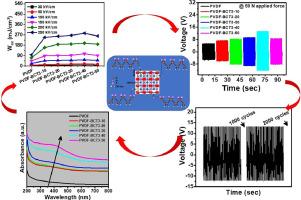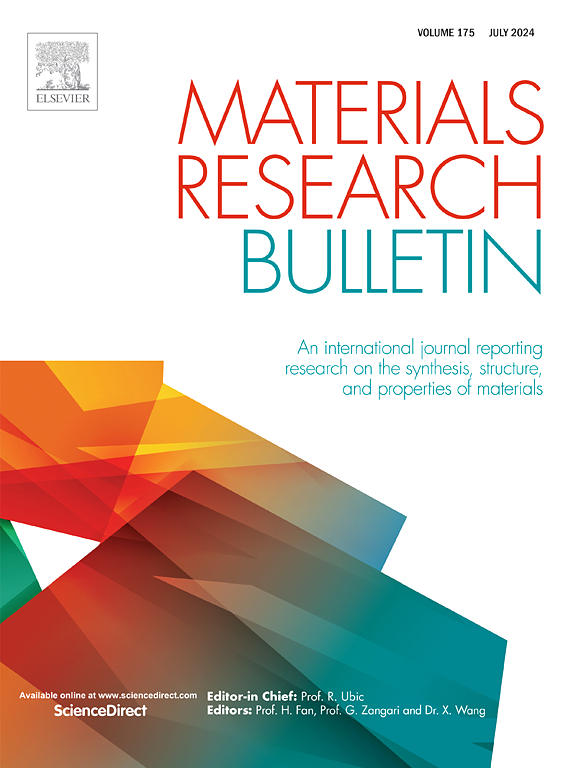Flexible PVDF-Ba0.97Ca0.03TiO3 polymer-ceramic composite films for energy storage, biosensor, mechanosensor, and UV–visible light protection
IF 5.7
3区 材料科学
Q2 MATERIALS SCIENCE, MULTIDISCIPLINARY
引用次数: 0
Abstract
Multifunctional piezoelectric devices, which can detect pressure, store electrostatic energy, block UV radiation, and generate electricity from body movements, are highly beneficial for enhancing individual well-being. To achieve these capabilities, polyvinylidene fluoride (PVDF) composite films with Ba0.97Ca0.03TiO3 (BCT3) filler were prepared, varying the BCT3 content from 0 to 50 wt.%. The BCT3 ceramic, prepared using a modified solid-state reaction, exhibits a tetragonal phase at room temperature with a d33 value of 105 pC/N. X-ray diffraction confirms composite formation. The beta phase ranges from 75 to 86.9 %. At 40 wt.% BCT3, the dielectric constant, energy density, and piezoelectric properties peak, yielding maximum Wrec and Wtot of 138.1 and 284.7 mJ/cm3 (@ 250 kV/cm), respectively. PVDF-BCT3-40 (40 wt.%) shows maximum voltage, current, and power density of 25 V, 26.8 nA, and 19.8 μW/cm3 under a 50 N load. Increasing BCT3 content enhances UV–visible absorbance, making the composites effective for light shielding.

用于能量存储、生物传感器、机械传感器和紫外线可见光防护的柔性 PVDF-Ba0.97Ca0.03TiO3 聚合物-陶瓷复合薄膜
多功能压电器件可以检测压力、存储静电能量、阻挡紫外线辐射并利用身体运动发电,对提高个人健康水平大有裨益。为了实现这些功能,我们制备了含有 Ba0.97Ca0.03TiO3(BCT3)填料的聚偏二氟乙烯(PVDF)复合薄膜,BCT3 的含量从 0 到 50 wt.%不等。采用改良固态反应制备的 BCT3 陶瓷在室温下呈四方相,d33 值为 105 pC/N。X 射线衍射证实了复合材料的形成。β相占 75% 到 86.9%。BCT3 的重量百分比为 40 时,介电常数、能量密度和压电特性达到峰值,最大 Wrec 和 Wtot 分别为 138.1 和 284.7 mJ/cm3(@ 250 kV/cm)。在 50 N 负载下,PVDF-BCT3-40(40 wt.%)的最大电压、电流和功率密度分别为 25 V、26.8 nA 和 19.8 μW/cm3。增加 BCT3 的含量可提高紫外线可见吸收率,使复合材料具有有效的光屏蔽作用。
本文章由计算机程序翻译,如有差异,请以英文原文为准。
求助全文
约1分钟内获得全文
求助全文
来源期刊

Materials Research Bulletin
工程技术-材料科学:综合
CiteScore
9.80
自引率
5.60%
发文量
372
审稿时长
42 days
期刊介绍:
Materials Research Bulletin is an international journal reporting high-impact research on processing-structure-property relationships in functional materials and nanomaterials with interesting electronic, magnetic, optical, thermal, mechanical or catalytic properties. Papers purely on thermodynamics or theoretical calculations (e.g., density functional theory) do not fall within the scope of the journal unless they also demonstrate a clear link to physical properties. Topics covered include functional materials (e.g., dielectrics, pyroelectrics, piezoelectrics, ferroelectrics, relaxors, thermoelectrics, etc.); electrochemistry and solid-state ionics (e.g., photovoltaics, batteries, sensors, and fuel cells); nanomaterials, graphene, and nanocomposites; luminescence and photocatalysis; crystal-structure and defect-structure analysis; novel electronics; non-crystalline solids; flexible electronics; protein-material interactions; and polymeric ion-exchange membranes.
 求助内容:
求助内容: 应助结果提醒方式:
应助结果提醒方式:


